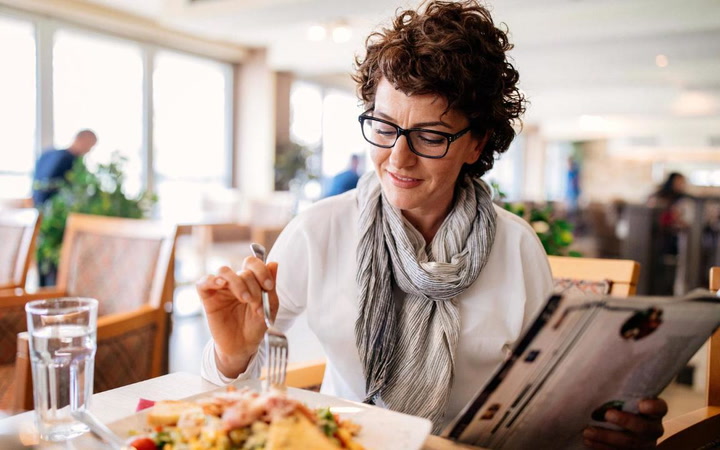Traveling solo can be one of the most satisfying and self-indulgent travel experiences: You can skip the sights you don’t want to see and dawdle at the ones you do, bolster a sense of independence, and eat anything (and everything) you want.
However, the idea of eating alone can throw some solo travelers into a funk, especially when they perceive the stares of onlookers who wonder why you don’t have a plus-one.
“Since the beginning of time, meals have been socially structured to be shared with another person — and even better because you can try out more than one dish at a time,” says Chizoba Anyaoha, founder of TravSolo, a planning app for solo travelers. “It’s more discouraging when you see other people eating together, sharing laughs, and looking like they’re having the time of their lives, while you have no choice but to eat alone.”
Moreover, in addition to feeling like they’re missing out, solo travelers may feel judged by others. “People incorrectly assume that no one would ever be alone, travel alone, or eat alone by choice — and they default to pity for that person,” explains Angela Skowronek, founder of SheGoes Solo Travel, an online resource that empowers women to travel happily alone.
Nonetheless, eating solo doesn’t have to be a sad experience. Here, experts offer advice on how to embrace and even enjoy dining alone.

1. Go Casual for Your First Solo Meal
“If you want to ease yourself into dining alone, start with breakfast or lunch in a diner or casual café, rather than dinner at a high-end restaurant,” says Skowronek. “It’ll seem less serious — and like less of an undertaking if you’re just grabbing a casual bite in daylight.”
Additionally, it might also ease your nerves to avoid restaurants that ooze romance, with dimly lit or candlelit spots and lots of couples dining together. “Choose instead a place where the diners are diverse and the setting is informal because you may find it easier to blend in and enjoy yourself without feeling out of place,” advises Skowronek.
2. Select a Seat at the Bar or a Communal Table
Search out restaurants with ample bar seating, where you can pull up a stool by other solo travelers or those looking for conversation, suggests Anyaoha. “Every time I have done this, I have always made friends with the bartender and with people who order drinks around me,” he says, adding that those casual conversations have sometimes led to lasting friendships.
3. Try to Stay in the Present
There are big pluses to eating alone: “When you’re alone, you have the ability to be far less distracted, more focused, and more observant,” Skowronek points out. Lean into these advantages by making choices that allow you to enjoy being in the moment. “Sit somewhere that faces the street or the door so that you can people-watch, if possible,” she continues. “Make an effort to notice the atmosphere of the place: what sounds you hear and what smells are wafting your way. And eat slowly — enjoy and appreciate every bite.”
4. Or Bring Along a Distraction
If you can’t stand the thought of being present in the moment, then bring along a distraction while you dine. “Try out different ways to occupy yourself while you enjoy your meal, like bringing that one book you have been trying to find time to finish or adding more notes to your journal,” says Anyaoha.
5. Maintain Your Perspective
When your solo dining nerves get the best of you — or you spot wandering eyes watching you — remember: “This is one meal of tens of thousands you’ll eat in your lifetime,” says Skowronek. “It’s one restaurant, one day of your life. If you’re traveling, you’ll likely never see any of the waiters or fellow diners again. What do you have to lose by going for it and embracing it? Remember how low the stakes truly are. The worst-case scenario is that you feel awkward. The best-case scenario is that you have a wonderful time, feel empowered, and maybe even inspire someone who sees you to try solo dining themselves one day.”
6. And Remember, Practice Makes Perfect
As Skowronek points out, “Being comfortable with dining alone is not an ingrained trait you’re either born with or not. It’s a skill you can build, just like learning a language or playing the piano.” Like those other skills, the process of honing it is the same: If you keep practicing, you will eventually see progress. “Start small with breakfast in a casual café, and work your way up,” advises Skowronek. “Don’t give up after one time that felt awkward or uncomfortable. Try again. Learn from your mistakes. If one type of restaurant or place to sit felt better to you than another, store that knowledge for next time. Be patient with yourself, and remember you’ll get better at this.”





